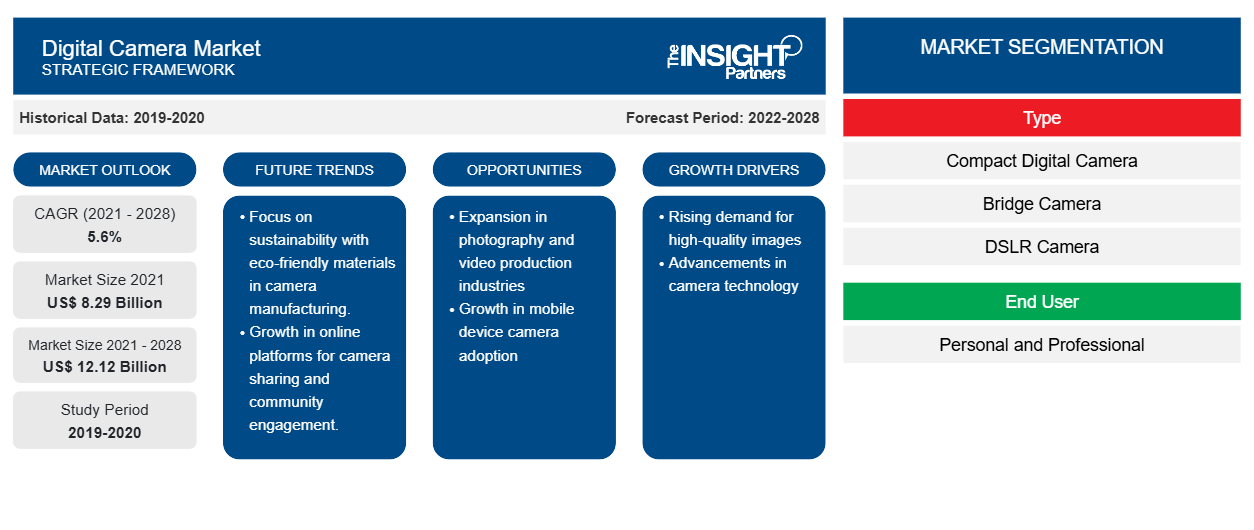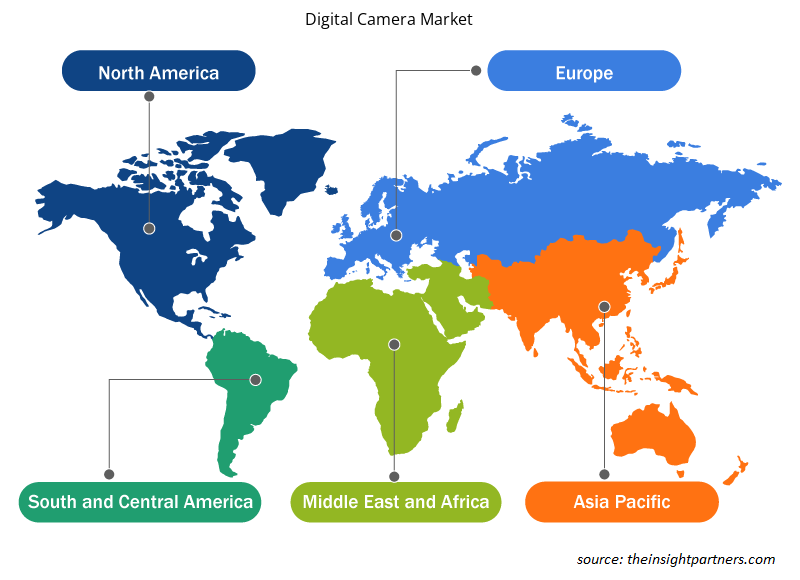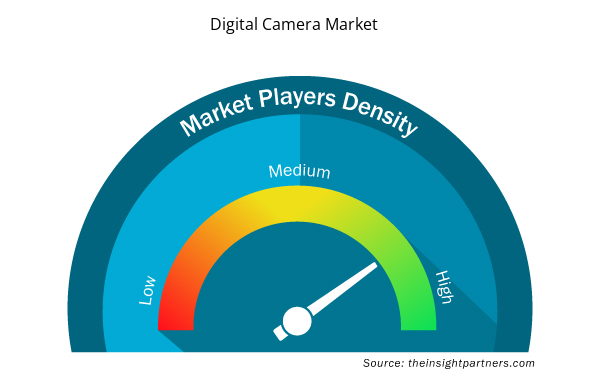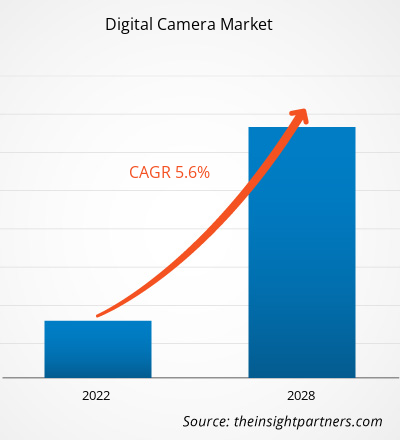The digital camera market is expected to grow from US$ 8,290.25 million in 2021 to US$ 12,119.44 million by 2028; it is estimated to grow at a CAGR of 5.6% during 2021–2028.
The use of digital cameras has not just been limited to personal and professional photography, but has been extended across entertainment, media, and sports industries. The film industry is one of the largest and most lucrative categories in the global entertainment industry. For instance, China's film industry is one of the world's largest film industries, churning out revenue of about US$ 6.6 billion in 2016. This promising outlook of the film and entertainment industry is expected to drive the demand for digital cameras to achieve perfect shots and videos. Rapid technological changes, consumer behavior, and business models have changed the way consumers want to experience and pay for entertainment and the media. The leaders in this industry are concentrating on building fan-focused businesses and brands to produce outstanding content. As a result, they invest a significant amount on technologies and equipment such as computer-generated image (CGI) and visual effects (VFX), as well as advanced cameras.
Also, there is indispensable use of digital cameras in sports media. The installation of high speed and digital cameras at stadium offers spectators to see slow motion replays at critical game situations and helps obtain accuracy while watching. Similarly, the use of high-resolution digital cameras in wildlife, landscape, architecture, and studio photography helps obtain sharp and crisp images and videos. The rising focus toward action photography has subsequently promoted the demand for compact digital cameras, such as GoPro. Further, social media platforms, such as Instagram, have substantially expanded the scope for photography, which, in turn is expected to proliferate the growth of the digital camera market
Customize This Report To Suit Your Requirement
You will get customization on any report - free of charge - including parts of this report, or country-level analysis, Excel Data pack, as well as avail great offers and discounts for start-ups & universities
Digital Camera Market: Strategic Insights

- Get Top Key Market Trends of this report.This FREE sample will include data analysis, ranging from market trends to estimates and forecasts.
Customize This Report To Suit Your Requirement
You will get customization on any report - free of charge - including parts of this report, or country-level analysis, Excel Data pack, as well as avail great offers and discounts for start-ups & universities
Digital Camera Market: Strategic Insights

- Get Top Key Market Trends of this report.This FREE sample will include data analysis, ranging from market trends to estimates and forecasts.
Impact of COVID-19 Pandemic on Europe Digital Camera Market :
The coronavirus pandemic has affected economies and industries in various countries due to lockdowns, travel bans, and business shutdowns. The consumer electronics industry is one of the major industries suffering serious disruptions such as supply chain breaks, shutdowns of production plants, etc., because of this pandemic. The shutdown of various manufacturing plants and factories in leading regions such as North America, Europe, Asia Pacific, South America, and the Middle East, and Africa has affected the global supply chain and negatively impacted the manufacturing, delivery schedules, and sales of various goods. Furthermore, various companies have already announced possible delays in product deliveries and slump in future sales of their products. In addition to this, the global travel bans imposed by countries in Europe, Asia, and North America are affecting the business collaborations and partnerships opportunities. All these factors are anticipated to affect the consumer electronics industry in a negative manner and thus act as restraining factor for the growth of various markets related to this industry in the coming months. The market for digital camera is impacted by the pandemic due to shortfall in production along with limited transportation facilities.
Digital Camera Market Insights
Technological Innovations Associated with Digital Cameras to Fuel Growth of Digital Camera Market
The framework of digital camera market is closely associated with emerging radical trends backed with innovative technological developments and robust advancements, such as HD and touch screen. Since a long time, the market has observed a higher demand for digital single-lens reflex camera and SLR camera market owing to growing consumer inclination toward advanced photography. However, the advancement of technology has resulted in creation of high-resolution cameras, which provides 12–20 megapixels. The continuous evolution in the field of digital cameras has resulted in designing advanced cameras with better resolution, faster focusing, and support to different peripherals. Also, an increase in trend to incorporate a Wi-Fi or 4G modem in digital cameras have also been observed to provide competitive edge over smartphones. Moreover, such cameras are foreseen to be a part of several interconnected devices, such as IoT (Internet-of-Things), which could facilitate effective communication with other interconnected devices such as smartphones and speaker assistants in the near future.
Type-Based Market Insights
Based on type, the digital camera market is categorized into compact digital camera, bridge camera, DSLR camera, mirrorless camera, digital rangefinder camera, and line-scan camera. In 2020, the DSLR camera segment accounted for the largest share in the market.
Digital Camera Market Regional Insights
The regional trends and factors influencing the Digital Camera Market throughout the forecast period have been thoroughly explained by the analysts at Insight Partners. This section also discusses Digital Camera Market segments and geography across North America, Europe, Asia Pacific, Middle East and Africa, and South and Central America.

- Get the Regional Specific Data for Digital Camera Market
Digital Camera Market Report Scope
| Report Attribute | Details |
|---|---|
| Market size in 2021 | US$ 8.29 Billion |
| Market Size by 2028 | US$ 12.12 Billion |
| Global CAGR (2021 - 2028) | 5.6% |
| Historical Data | 2019-2020 |
| Forecast period | 2022-2028 |
| Segments Covered |
By Type
|
| Regions and Countries Covered | North America
|
| Market leaders and key company profiles |
Digital Camera Market Players Density: Understanding Its Impact on Business Dynamics
The Digital Camera Market market is growing rapidly, driven by increasing end-user demand due to factors such as evolving consumer preferences, technological advancements, and greater awareness of the product's benefits. As demand rises, businesses are expanding their offerings, innovating to meet consumer needs, and capitalizing on emerging trends, which further fuels market growth.
Market players density refers to the distribution of firms or companies operating within a particular market or industry. It indicates how many competitors (market players) are present in a given market space relative to its size or total market value.
Major Companies operating in the Digital Camera Market are:
- Canon Inc.
- Eastman Kodak Company (JK Imaging Ltd.)
- Fujifilm Holdings Corporation
- Leica Camera Ag
- Nikon Corporation
Disclaimer: The companies listed above are not ranked in any particular order.

- Get the Digital Camera Market top key players overview
End User-Based Market Insights
Based on application, the digital camera market is segmented into personal and professional. In 2020, the professional segment accounted for a larger market share.
The players operating in the digital market adopt strategies such as mergers, acquisitions, and market initiatives to maintain their positions in the market. A few developments by key players are listed below:
- FUJIFILM Holdings Corporation announced about the launch of FUJIFILM GFX100S in late February 2021. The camera is the latest addition to the GFX Series of mirrorless digital cameras.
- Nikon Corporation had launched the Z 7II full-frame mirrorless camera. The Z 7II is a full-frame, high-resolution mirrorless camera. Through such product launches, the company is contributing to the development of imaging culture.
The digital camera market has been segmented as follows:
By Type
- Compact Digital Camera
- Bridge Camera
- DSLR Camera
- Mirrorless Camera
- Digital Rangefinder Camera
- Line-Scan Camera
By End User
- Personal
- Professional
By Geography
North America
- US
- Canada
- Mexico
Europe
- France
- Germany
- Italy
- UK
- Russia
- Rest of Europe
Asia Pacific (APAC)
- China
- India
- South Korea
- Japan
- Australia
- Rest of APAC
Middle East & Africa (MEA)
- South Africa
- Saudi Arabia
- UAE
- Rest of MEA
South America (SAM)
- Brazil
- Argentina
- Rest of SAM
Company Profiles
- Canon Inc.
- Eastman Kodak Company
- Fujifilm Holdings Corporation
- Leica Camera Ag
- Nikon Corporation
- Om Digital Solutions Corporation
- Panasonic Corporation
- Hasselblad
- Ricoh Imaging Company, Ltd,
- Sony Corporation
- Historical Analysis (2 Years), Base Year, Forecast (7 Years) with CAGR
- PEST and SWOT Analysis
- Market Size Value / Volume - Global, Regional, Country
- Industry and Competitive Landscape
- Excel Dataset



Report Coverage
Revenue forecast, Company Analysis, Industry landscape, Growth factors, and Trends

Segment Covered
Type and End User

Regional Scope
North America, Europe, Asia Pacific, Middle East & Africa, South & Central America

Country Scope
Argentina, Australia, Brazil, Canada, China, France, Germany, India, Italy, Japan, Mexico, Russian Federation, Saudi Arabia, South Africa, South Korea, United Arab Emirates, United Kingdom, United States
Frequently Asked Questions
DSLR cameras held the largest share in 2020 and they are the most versatile, high-end, and advanced type cameras. These cameras use single-lens reflex method. They consist of a mirror, which reflects the light passing through the lens. DSLR cameras are mostly large in size. These cameras are mainly used by professional photographers or videographers for commercial purposes. Automatic mode and changeable camera lens to fit different situations are the important feature of DSLR cameras. However, DSLR camera manufacturers are now focusing on integrating software enhancements and other technologies in these cameras for enhanced consumer experience, this factor is expected to drive the demand in the coming years.
With the growing trend toward photography, the demand for digital cameras is expanding. Digital camera allows to capture and store photos and videos digitally rather than printing it to film as per traditional analog cameras. As the consumers are becoming enthusiastic toward sight capturing, the demand for compact, lightweight, and high-quality cameras is rising. Further, the introduction of digital cameras and smartphones has created photography a mainstream profession, which have subsequently generated the need for high quality cameras with user-friendly interface and affordable price.
Mirrorless cameras are expected to drive the future growth of digital camera market. A mirrorless system camera does not involve a mirror box within its body and are designed with a compact and attractive exterior with an electronic viewfinder paired with interchangeable lens. Such cameras offer convenience in use compared to digital SLR cameras owing to their smaller and lighter structure. Mirrorless camera comprises lens at the front body along with sensor placed inside and a screen along with an optional viewfinder placed at the back. Additionally, such cameras have small, short, and light lenses and are constructed with a tiny LED or OLED screen, which helps to deliver best possible results altogether. Hence, the expanding demand for mirrorless cameras is expected to create lucrative opportunities for the growth of the digital cameras market.
Trends and growth analysis reports related to Electronics and Semiconductor : READ MORE..
The List of Companies - Digital Camera Market
- Canon Inc.
- Eastman Kodak Company (JK Imaging Ltd.)
- Fujifilm Holdings Corporation
- Leica Camera Ag
- Nikon Corporation
- Om Digital Solutions Corporation
- Panasonic Corporation
- Hasselblad
- Ricoh Imaging Company, Ltd
- Sony Corporation

 Get Free Sample For
Get Free Sample For